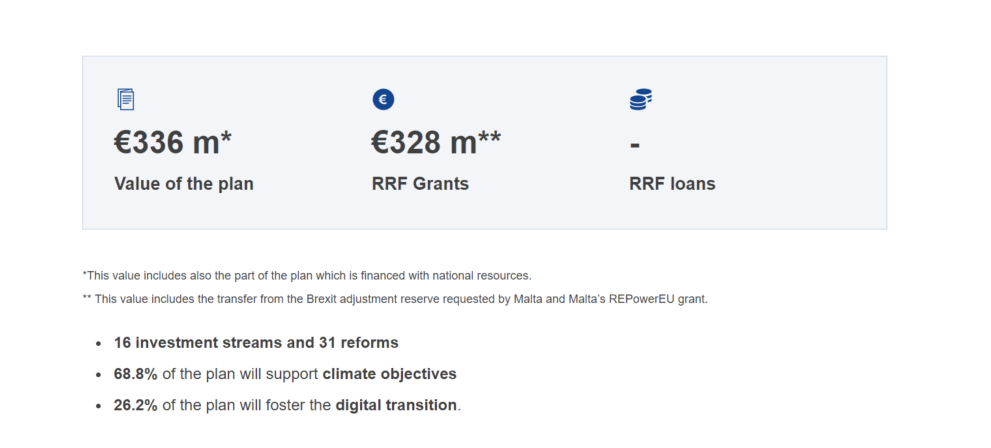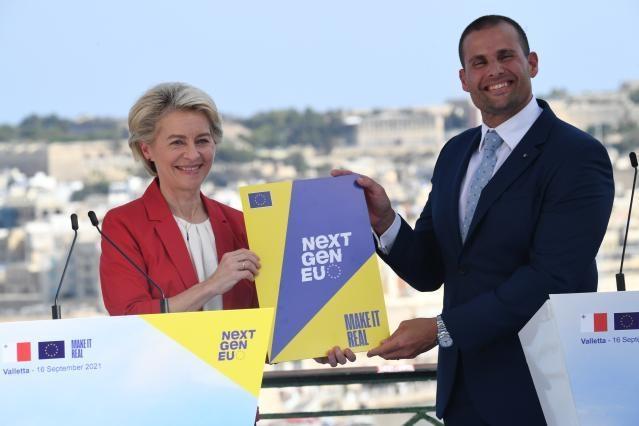In December of 2020, the leaders of all European Union countries, the European Parliament and the European Commission agreed on a Recovery Plan to help repair the economic and social damage brought about by the COVID-19 pandemic.
Through the EU’s long-term budget, together with the temporary NextGenerationEU instrument, a total of more than €2 trillion is helping build a greener, more digital and more resilient Europe.
The Recovery Plan for Malta
Europe’s recovery from the economic, financial and social consequences of the COVID-19 pandemic is of vital importance to Malta’s economic interests, particularly given the importance of its tourism industry.
In its Spring 2023 Economic Forecast, the Commission stated that Malta’s economy grew strongly by 6.9% in 2022, driven by domestic demand and export of services, benefiting from the further recovery in tourism. . Growth is forecast to moderate to 3.9% in 2023, as high inflation affects household disposable incomes and consumption. GDP growth is set to reach 4.1% in 2024. Sizeable government measures helped to keep energy prices unchanged in Malta.

What’s in the Recovery Plan for Malta?
NextGenerationEU, the EU’s temporary recovery instrument, is supporting Malta by helping to mitigate the impact of the coronavirus pandemic and overcome the energy crisis due to Russia’s war in Ukraine, and by helping to make Malta’s economy more resilient. Maltese participating in a Eurobarometer survey published in July 2023, have expressed the most positive opinion EU-wide regarding NextGenerationEU. 88% believe that the NextGenerationEU recovery plan can be an effective measure to respond to current economic challenges.
• Malta is set to receive €328 in Recovery and Resilience Facility grants. This financing will support the implementation of the crucial investment and reform measures outlined in Malta's recovery and resilience plan. The plan covers seven areas, including sustainable transport, circular economy, renewable energy, energy-efficiency in buildings, digital transformation of the public administration and the legal system, projects targeting the health and education sectors, as well as institutional reforms. It devotes 68.8% of its total allocation to measures that support climate objectives and 26.2% to measures that support the digital transition.
• Malta is also receiving €872 million in Cohesion Policy and €185 in agriculture and fishery funds from the 2021-2027 EU budget.
• The Commission has disbursed €420 million in financial support to Malta under the SURE instrument. This financial support was provided in the form of loans ggranted on favourable terms and assisted Malta in addressing sudden increases in public expenditure to preserve employment in the context of the pandemic.

Delivering Malta’s Recovery Plan
Malta submitted its recovery and resilience plan 13 July 2021. On 16 September 2021, the Commission adopted a positive assessment of Malta’s recovery and resilience plan. Presenting the assessment, President von der Leyen said “This plan excels as one of the greenest plans the Commission has approved so far.”
The reforms and investment in Malta’s plan are helping it become more sustainable, resilient and better prepared for the challenges and opportunities offered by the green transition and digital transition. Following Council approval of Malta’s plan on 5 October 2021, Malta’s recovery and resilience plan was updated on 14 July 2023 to introduce reforms that address REPowerEU objectives.
The transformative impact of Malta’s plan is the result of a strong combination of reforms and investment which addresses the country’s specific challenges. The reforms are aimed towards strengthening the rule of law and the fight against corruption, while investment is targeted at the green and digital transitions, as well as tackling challenges related to health and skills.
All measures have to be implemented within a tight timeframe, as the Regulation establishing the Recovery and Resilience Facility requires all milestones and targets within the national plans to be completed by August 2026.
REPowerEU measures in Malta’s plan
Malta’s plan now includes one reform and one investment to reduce its reliance on fossil fuels, in line with one of the REPowerEU Plan's objectives.
To finance this increased ambition, Malta has asked for a share of its Brexit Adjustment Reserve to be transferred to the plan, amounting to €40 million. These funds would be added to Malta's REPowerEU grant of €30 million.
Key measures for REPowerEU
The REPowerEU measures include a reform of the permitting system for renewable energy projects and a EUR 70 million investment in the electricity grid.
The reform will help accelerate procedures for granting permits for renewable energy projects and introduce an obligation to install rooftop solar panels on certain new buildings.
The investment will strengthen and expand the electricity grid and distribution services, while also building centralised battery storage capacity.
Together, these measures are expected to increase Malta’s share of renewable energy and accelerate decarbonisation of energy generation, building and transport sectors.
Green transition
In the area of climate and environmental policies, Malta’s challenges include the need to reduce greenhouse gas emissions, decarbonise transport and reduce congestion, make the building stock more energy-efficient and improve waste and water management.
Key measures for the green transition
- The plan supports the green transition through the large-scale electrification of road transport.
- An investment of €60 million will promote the purchase of zero-emission electric vehicles for the public and private sector.
- The purchase of 102 electric buses for public transport for €34 million and a reform granting free public transport to all Tallinja Card holders will boost the use of public transport and help address congestion.
- A large-scale energy-efficiency programme for public schools, hospitals and offices, as well as private buildings worth €52.2 million will lead to a sizable reduction of greenhouse gas emissions.
- Malta’s recovery and resilience plan includes important measures to improve waste management, including with regard to construction and demolition waste.
The modified plan, including the REPowerEU chapter, has further strengthened the focus of the plan on the green transition, devoting 68.8% of the available funds to measures that support climate objectives (up from 53.8% in the original plan).
Digital transition
Digital challenges for Malta include differences in digitalisation between large and small enterprises, as well as digital skills shortages and mismatches.
Key measures for the digital transition
Malta’s recovery and resilience plan supports the digital transition with investments and reforms in the public and private sectors.
- Investments into digitalisation of the public administration and public services (€34 million) to strengthen the government’s IT systems and enhance digital public services.
- Investments in the digitalisation of at least 360 companies, in particular SMEs (€15 million).
- Reforms include the adoption of Malta’s Digital Strategy 2021-2027, which aims to reduce the digital divide, notably by supporting families with low income to get connected and have access to computers, and to promote digital skills.
The modified plan has further strengthened the focus of the plan on the digital transition, devoting 26.2% of the available funds to measures that support digital objectives (up from 25.5% in the original plan).
Economic and social resilience
Key challenges with an impact on Malta’s medium-term economic performance include a shortage of skilled labour, challenges related to an ageing population, and weaknesses in the regulatory and supervisory framework, which prevent businesses from taking full advantage of the opportunities offered by the green and digital transitions.
Key measures in reinforcing economic and social resilience
The plan contains a set of reforms and investments that reinforce economic and social resilience.
- It includes crucial reforms to strengthen the judiciary’s independence, to address some features of the tax system that facilitate aggressive tax planning and to strengthen the institutional framework in order to fight against corruption and money laundering.
- Reforms aim to strengthen early school leaving intervention and prevention measures, expand guidance and opportunities for upskilling and reskilling for all adults, and in particular for the low skilled, and enhance quality inclusive education for pupils with special needs.
- An investment in the Blood, Tissue and Cell Centre is expected to strengthen the resilience of the national health system by providing services for which patients previously had to travel abroad.
Malta’s Recovery and Resilience Plan
National Recovery and Resilience website
REPowerEU Plan: Affordable, secure and sustainable energy for Europe
European Semester documents for Malta

What is in the Recovery Plan for Europe?
The long-term EU budget, which was topped up to meet the COVID-related challenges, ensures that more than 50% of the Recovery Plan is dedicated to modernisation, through research and innovation, climate and digital transitions, and preparedness, recovery and resilience.
This forward-thinking package, in line with the European Green Deal, will fight climate change. 30% of the EU budget will be spent on this priority. It will also pay specific attention to biodiversity protection.
NextGenerationEU will provide an additional €806.9 billion, of which €723.8 billion (in current prices) will be delivered through the Recovery and Resilience Facility (RRF) in the form of loans and grants to support the reforms and investments undertaken by EU countries. The European Commission has also implemented a new Technical Support Instrument (TSI) to provide tailor-made expertise for EU countries to design and implement reforms. Read more about the TSI and some of the reform projects being supported.
The European Semester, which is the framework to coordinate and monitor economic policy, has also been adapted as it is closely linked to the Recovery and Resilience Facility, and will ensure that reforms are an integral part of the recovery for each country.
To access funds from the Recovery and Resilience Facility, Member States provide a national recovery and resilience plan, in which at least 37% of expenditure is allocated to climate and 20% to digital investments and reforms, and which must be implemented by 2026.
Recovery and Resilience FacilityNext Generation EUEuropean Semester 2023 Country Report for Malta 3
EU funding and tenders programmes and application procedures
The EU’s 2021-2027 long-term budget & NextGenerationEU: Facts and figures
Related Links
Map of projects supported by the Recovery and Resilience Facility
This map provides examples of reforms and investments supported by the Recovery and Resilience Facility in the different EU Member States. It is not an exhaustive database of projects supported by the Facility and will be regularly updated as the implementation progresses. The funding amounts shown reflect the initial cost estimates included in the national recovery and resilience plans.
